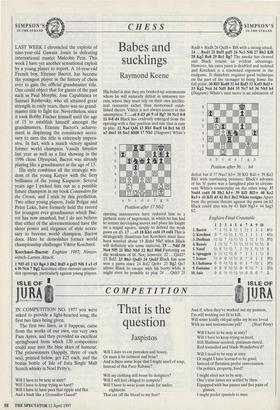SIMPSON'S
IN-THE-STRAND
SIMPSON'S
IN-THE-STRAND
Babes and sucklings
Raymond Keene
LAST WEEK I chronicled the exploits of nine-year-old Gawain Jones in defeating international master Malcolm Pein. This week I have yet another sensational exploit by a young player to report. A 14-year-old French boy, Etienne Bacrot, has become the youngest player in the history of chess ever to gain the official grandmaster title. One could object that for giants of the past such as Paul Morphy, Jose Capablanca or Samuel Reshevsky, who all attained great strength in early years, there was no grand- master title to fight for. Nevertheless, since it took Bobby Fischer himself until the age of 15 to establish himself amongst the grandmasters, Etienne Bacrot's achieve- ment in displaying the consistency neces- sary to earn the title is extremely impres- sive. In fact, with a match victory against former world champion Vassily Smyslov last year as well as a fine showing in the 1996 chess Olympiad, Bacrot was already playing like a grandmaster at the age of 13.
His style combines all the strategic wis- dom of the young ICarpov with the fiery brilliance of the young Kasparov. Several years ago I picked him out as a possible future champion in my book Contenders for the Crown, and I stick by this prediction. Two other young players, Judit Polgar and Peter Leko, have formerly held the record for youngest ever grandmaster which Bac- rot has now smashed, but I do not believe that either of the aforementioned have the sheer power and elegance of style neces- sary to become world champion. Bacrot does. Here he demolishes former world championship challenger Vilctor Korchnoi.
Korchnoi—Bacrot: Enghien 1997; Nitnzo- witsch-Larsen Attack.
1 N13 d5 2 b3 Bg4 3 Bb2 Bxf3 4 gxf3 Nf6 5 e3 c5 6 f4 Nc6 7 Bg2 Korchnoi often chooses unortho- dox openings, particularly against young players.
His belief is that they are booked-up automatons whom he will naturally defeat in unknown ter- rain, where they must rely on their own intellec- tual resources rather than memorised estab- lished theory. Viktor is not always correct in this assumption. 7 ...e6 8 d3 g6 9 c4 Bg7 10 Nc3 0-0 11 0-0 d4 Black has evidently emerged from the opening with a fine position and one that is easy to play. 12 Na4 Qd6 13 Rbl Rac8 14 Bc1 b6 15 a3 dxe3 16 fxe3 Ftfd8 17 Nb2 (Diagram) White's opening manoeuvres have reduced him to a pathetic state of impotence, in which he has had to retract developing moves and place his knight on a stupid square, simply to defend the weak pawn on d3. 17 ...e5 18 Khl exf4 19 exf4 This is strategically disastrous but Korchnoi must have been worried about 19 Rxh4 Nh5 when Black will definitely win some material. 19 ...Nd4 20 Na4 Nf5 21 Rb2 Nh5 22 Re2 Bh6 Fastening on the weakness of f4. Not, however, 22 ... Qxd3? 23 Rd2. 23 Bh3 Qxd3 24 Qxd3 Black has now won a pawn since 24 Rd2 Qe4+ 25 Bg2 Qe7 allows Black to escape with his booty while it might even be possible to play 24 ... Qxh3 25 ftxd8+ Rxd8 26 Qxd8+ Bf8 with a strong attack. 24 ... Rxd3 25 Bxf5 gxf5 26 Nc3 Nf6 27 Bb2 Kf8 28 Kg2 Re8 29 Bel Bg7 The smoke has cleared and Black retains an evident advantage. However, his extra pawn is doubled and isolated and Korchnoi is a renowned exponent in the endgame. It therefore requires good technique on the part of the teenager to bring home the full point. 30 Rf3 Red8 31 b4 Rxf3 32 Kxf3 Rd3+ 33 Kg2 Ne4 34 Nd5 Bd4 35 Nc7 h5 36 Nb5 h4 (Diagram) White's next move is an admission of Position after 36. h4
defeat but if 37 Nxa7 h3+ 38 Kfl Rdl + 39 Ke2 Rhl with continuing pressure. Black's advance of his 'h' pawn was a farsighted plan to circum- vent White's counterplay on the other wing. 37 Nxd4 cxd4 38 11b2 h3+ 39 Kfl Rf3+ 40 Ke2 Re3+ 41 Kfl d3 42 Rd l Re2 White resigns Apart from the prosaic threats against the pawn on h2 Black could also win by 43 Bd4 Ng3+ 44 hxg3 h2.
Enghien Final Crosstable
1 2 3 4 5 6 7 8 9 10
1. Bacrot * 1
I/2
0 I/2 1 I/2 1 1
1
61/2
2. Korchnoi 0 *
1/2 1/2
1
1/2
1 1 1 1
61/2
3. Dorfman
1/2 1/2
*
1/2 1/2 1/2
1
1/2
1
1/2 51/2
4. Rausis 1
1/2 1/2 * 1/2 1/2 1/2 1/2 1/2 1/2 5
5. Nataf
1/2
0
1/2 1/2
* 1
1/2
1
1/2
1/2
5 6. Spraggett 0
1/2 1/2 1/2
0 * 1 1 1
1/2
5 7. Ivanov
1/2
0 0
1/2 1/2
0 * 0 1 1
31/2
8. Chabanon 0 0
1/2 1/2
0 0 1 *
1/2
1
31/2
9. Fontaine 0 0 0
1/2 1/2
0 0
1/2
* 1
21/2
10. Anic 0 0
1/2 1/2 1/2 1/2 0 0 0 *
2


































































 Previous page
Previous page